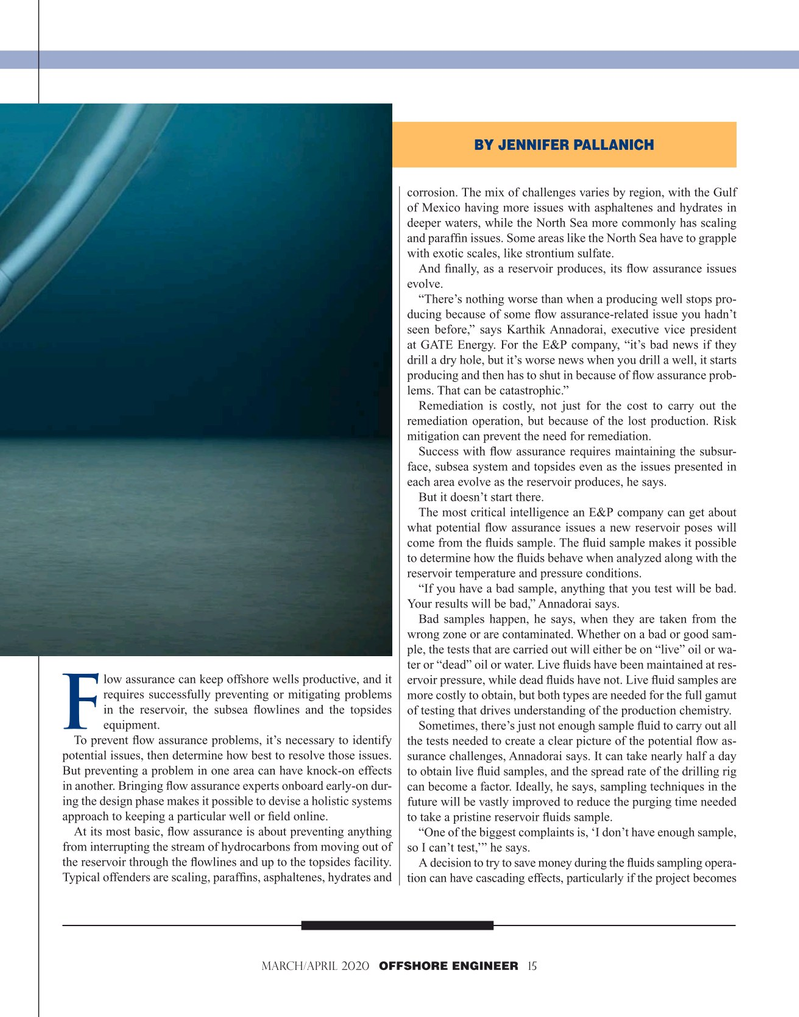
Page 15: of Offshore Engineer Magazine (Mar/Apr 2020)
Offshore Wind Outlook
Read this page in Pdf, Flash or Html5 edition of Mar/Apr 2020 Offshore Engineer Magazine
BY JENNIFER PALLANICH corrosion. The mix of challenges varies by region, with the Gulf of Mexico having more issues with asphaltenes and hydrates in deeper waters, while the North Sea more commonly has scaling and paraf?n issues. Some areas like the North Sea have to grapple with exotic scales, like strontium sulfate.
And ?nally, as a reservoir produces, its ?ow assurance issues evolve. “There’s nothing worse than when a producing well stops pro- ducing because of some ?ow assurance-related issue you hadn’t seen before,” says Karthik Annadorai, executive vice president at GATE Energy. For the E&P company, “it’s bad news if they drill a dry hole, but it’s worse news when you drill a well, it starts producing and then has to shut in because of ?ow assurance prob- lems. That can be catastrophic.”
Remediation is costly, not just for the cost to carry out the remediation operation, but because of the lost production. Risk mitigation can prevent the need for remediation.
Success with ?ow assurance requires maintaining the subsur- face, subsea system and topsides even as the issues presented in each area evolve as the reservoir produces, he says.
But it doesn’t start there.
The most critical intelligence an E&P company can get about what potential ?ow assurance issues a new reservoir poses will come from the ?uids sample. The ?uid sample makes it possible to determine how the ?uids behave when analyzed along with the reservoir temperature and pressure conditions.
“If you have a bad sample, anything that you test will be bad.
Your results will be bad,” Annadorai says.
Bad samples happen, he says, when they are taken from the wrong zone or are contaminated. Whether on a bad or good sam- ple, the tests that are carried out will either be on “live” oil or wa- ter or “dead” oil or water. Live ?uids have been maintained at res- low assurance can keep offshore wells productive, and it ervoir pressure, while dead ?uids have not. Live ?uid samples are requires successfully preventing or mitigating problems more costly to obtain, but both types are needed for the full gamut in the reservoir, the subsea ?owlines and the topsides of testing that drives understanding of the production chemistry.
F equipment. Sometimes, there’s just not enough sample ?uid to carry out all
To prevent ?ow assurance problems, it’s necessary to identify the tests needed to create a clear picture of the potential ?ow as- potential issues, then determine how best to resolve those issues. surance challenges, Annadorai says. It can take nearly half a day
But preventing a problem in one area can have knock-on effects to obtain live ?uid samples, and the spread rate of the drilling rig in another. Bringing ?ow assurance experts onboard early-on dur- can become a factor. Ideally, he says, sampling techniques in the ing the design phase makes it possible to devise a holistic systems future will be vastly improved to reduce the purging time needed approach to keeping a particular well or ?eld online. to take a pristine reservoir ?uids sample.
At its most basic, ?ow assurance is about preventing anything “One of the biggest complaints is, ‘I don’t have enough sample, from interrupting the stream of hydrocarbons from moving out of so I can’t test,’” he says.
the reservoir through the ?owlines and up to the topsides facility. A decision to try to save money during the ?uids sampling opera-
Typical offenders are scaling, paraf?ns, asphaltenes, hydrates and tion can have cascading effects, particularly if the project becomes march/april 2020 OFFSHORE ENGINEER 15

 14
14

 16
16